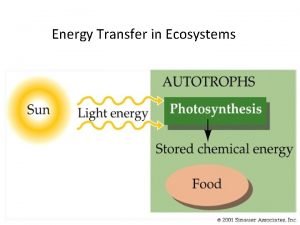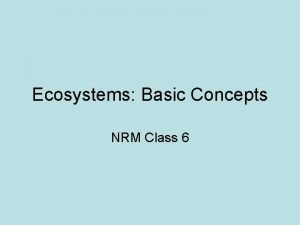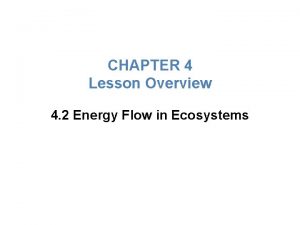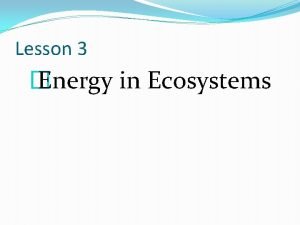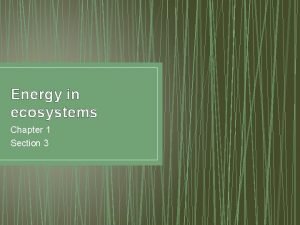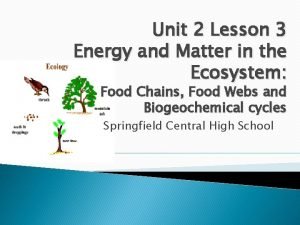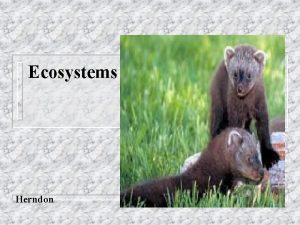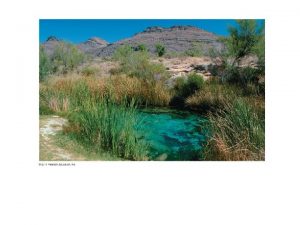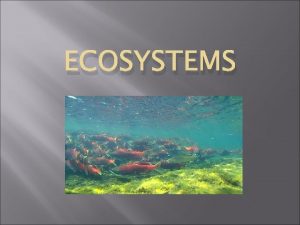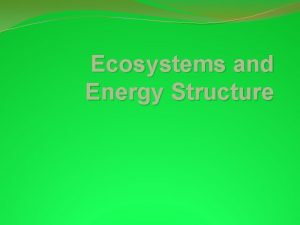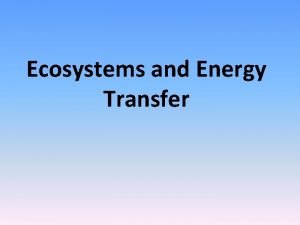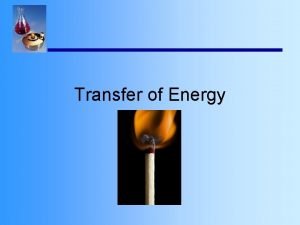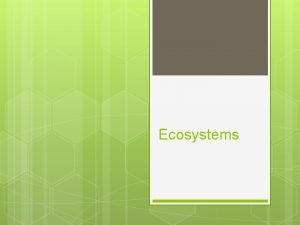Energy Transfer in Ecosystems An ecosystem is All









- Slides: 9

Energy Transfer in Ecosystems


An ecosystem is… • All of the biotic and abiotic components of an area. • The amount of energy an ecosystem receives has an effect on it’s composition (limiting factors). • All energy entering the ecosystem from the sun or other abiotic factors needs to be converted to be useful to other organisms (ie. photosynthesis).

Producers… Producers • autotrophs that convert energy entering the ecosystem into organic matter other organisms can use – ie. plants, protists, bacteria, algae • use solar energy to do photosynthesis some use inorganic molecules to do chemosynthesis (ie. bacteria)

Producers add biomass to an ecosystem. Biomass is all of the organic material (ie. plants) in an ecosystem available to organisms.

• Consumers are heterotrophs that must eat other organisms for nutrition. • Consumers are grouped according to their food consumption: – herbivores (plant eaters) eat producers (plants) – carnivores (meat eaters) eat other consumers (meat eaters) – omnivores eat both producers and consumers – detritivores eat wastes and parts of dead consumers and producers (some detritivores are decomposers)

All ecosystems have energy flow caused by organisms eating one another. • Energy flows through ecosystems from producers to consumers. • Energy is LOST by 10% as it goes UP the food chain/web. Most energy consumed contributes to maintaining homeostasis, respiration, growth, and reproduction.

Trophic Levels • An organism’s trophic level shows their position in the sequence of energy flow. • Producers belong to the 1 st trophic level (are most abundant). • Herbivores belong to the 2 nd trophic level (also called primary consumers). • Predators of herbivoes belong to the 3 rd trophic level (also called secondary consumers). • Most ecosystems only have 3 -4 trophic levels.

Food Chains • Food chains are single pathways of energy transfer. • The arrows represent the way the energy is flowing. • So the energy is flowing from the frog to the snake in this food chain. • Food chains are too simple to encompass a whole ecosystems interactions. Food Webs • Food webs are made of many interacting food chains. • More accurate than food chains since most organisms feed on more than one thing and are eaten by more than one thing. • If one part of the food web is lost there can be serious consequences for the entire ecosystem.
 Energy transfer in ecosystems
Energy transfer in ecosystems Provides practically all the energy for ecosystems
Provides practically all the energy for ecosystems Energy energy transfer and general energy analysis
Energy energy transfer and general energy analysis Energy energy transfer and general energy analysis
Energy energy transfer and general energy analysis Chapter 4 lesson 2 energy flow in ecosystems
Chapter 4 lesson 2 energy flow in ecosystems Energy in ecosystems lesson 3 answer key
Energy in ecosystems lesson 3 answer key Section 3 energy in ecosystems
Section 3 energy in ecosystems Chapter 42 ecosystems and energy
Chapter 42 ecosystems and energy Energy flow trophic levels
Energy flow trophic levels Phosphorus cycle
Phosphorus cycle
